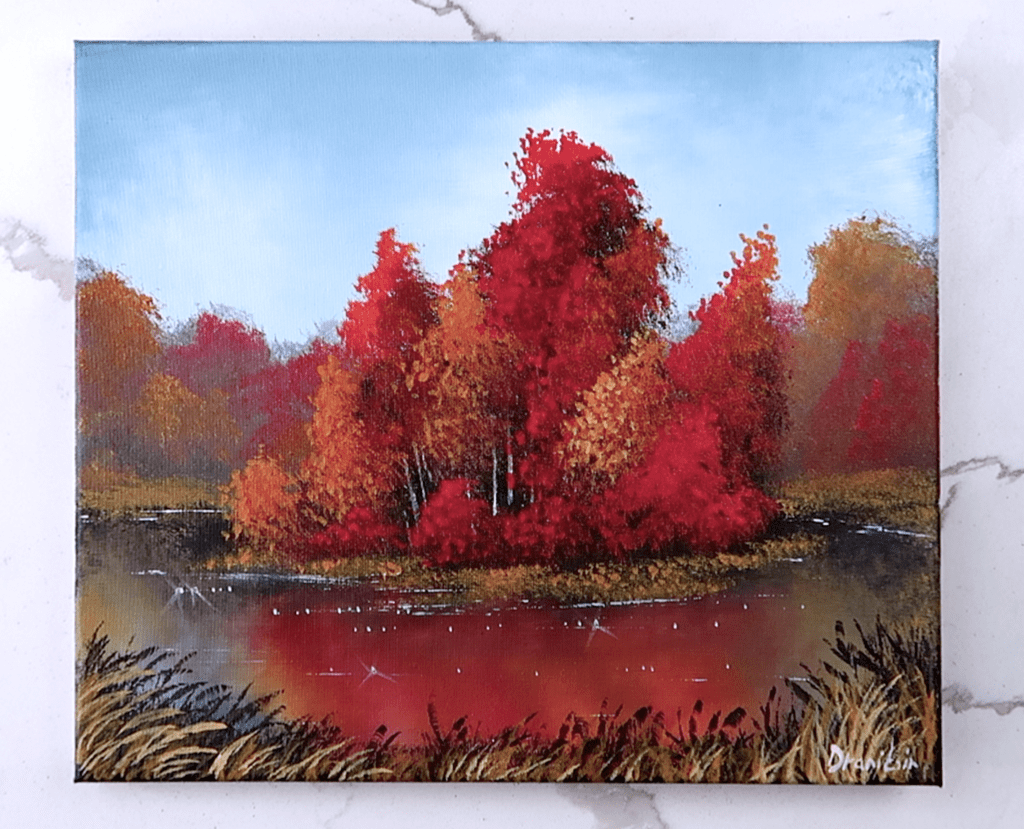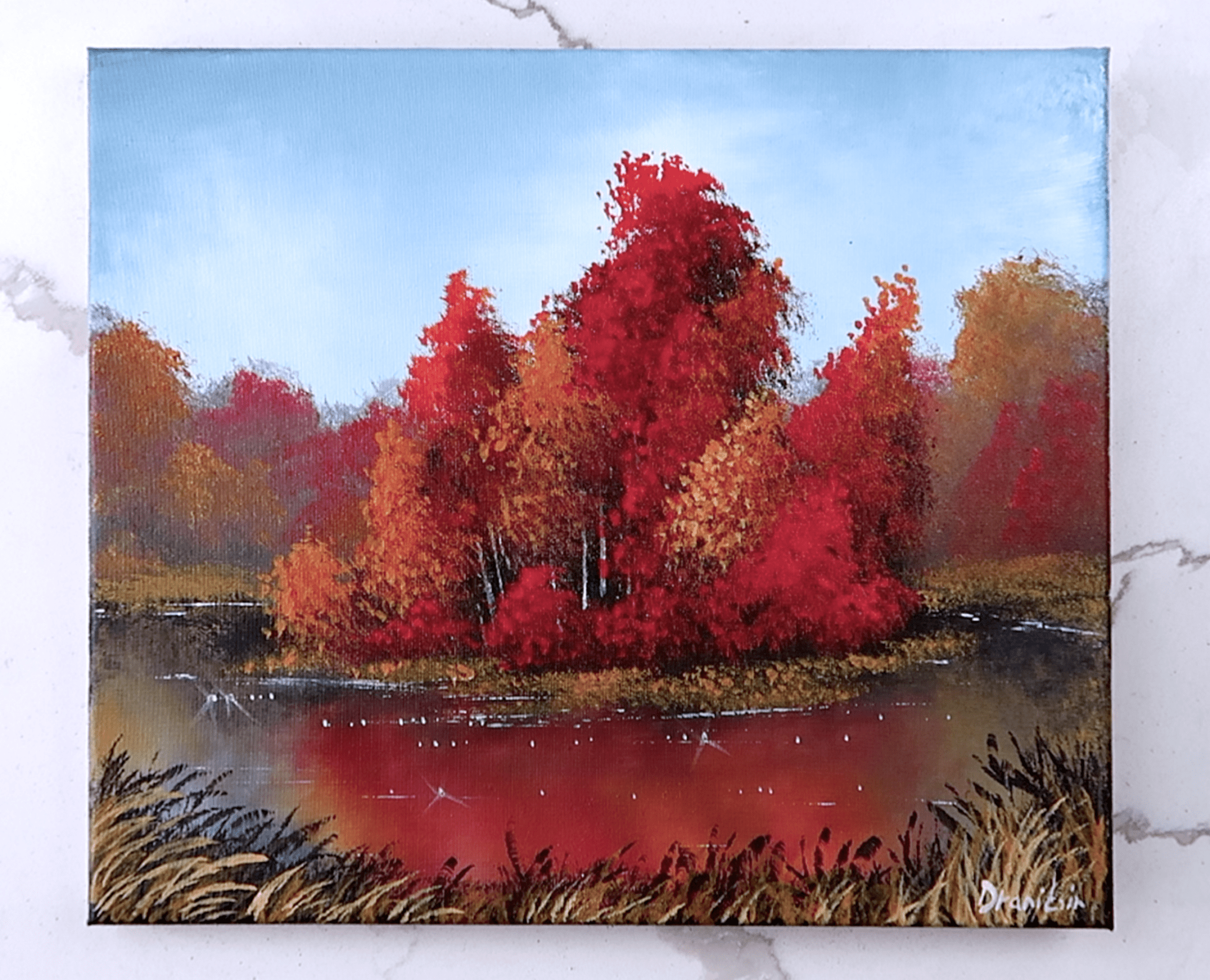Discover how texture can bring your acrylic landscapes to life with expert painting tips and techniques!
🎨 Why Texture is the Secret Ingredient in Acrylic Landscape Painting
Unleashing the power of texture in your acrylic painting opens up an entirely new dimension of creativity. Imagine creating depth in rolling mountains, enhancing the softness of fluffy clouds, or highlighting the rugged bark of a solitary tree. Whether you’re painting serene lakes or vibrant sunsets, mastering texture takes your landscape art to the next level.
Using unique painting techniques and tools like palette knives, fan brushes, and even unconventional materials helps you explore endless possibilities—perfect for creating breathtaking acrylic landscape paintings! Get started with premium-grade acrylic paints here.
⛰️ The Magic of Texture in Acrylic Landscape Art: 4 Game-Changing Techniques
- Palette Knife Mastery for Dimension
Break free from the flat canvas! With a palette knife, create realistic rugged rocks, mountain terrains, or textured foliage. The knife’s edge allows you to layer paint effortlessly, adding depth and vibrant contrast to your acrylic painting. Learn more painting tips here. Pro Tip: Use thick layers of acrylic paint in bold strokes to mimic natural elements like water ripples or hillsides. - Dry-Brush Techniques for Subtle Yet Striking Effects
Grab a round or flat paintbrush here and try the dry-brush method. This painting technique adds soft textures and gradients to skies, clouds, and grassy fields, giving an ethereal touch to your landscape painting. - Sponge Effects to Capture Nature’s Intricacy
Sponges aren’t just for cleanup—they give your work unique textures! Create dense foliage, shimmering lake surfaces, or mottled rock textures with sponge dabs and blended acrylic paints. Once you’ve mastered this, you’ll never see sponges the same way again! Get step-by-step tips here. - Layering for Realistic Landscapes
Achieve three-dimensional beauty by layering acrylic paint! Start with light washes, then gradually build up with thicker brushwork or a dry-brush method to give your acrylic landscape painting a sense of depth and life. Curious about using these painting techniques? Explore more here.
🌅 Top Inspirations to Bring Texture Alive in Your Art
- Golden Fields under Midnight Skies
Focus on creating texture in the stark contrast of soft wheat stalks and sharp shadows—perfect for blending bold acrylic techniques. - Serene Lakes with Reflective Ripples
Highlight water surfaces with a shimmering glaze of acrylic paint, then use detailed brush strokes to create tiny ripples. View more inspirational works in the Art Gallery. - Enchanted Forest with Bark and Canopy Layers
Use dry-brush work for leaves and palette knife strokes to capture the intricate textures of tree bark. Feeling inspired already? Try this with art supplies.
🖌️ Essential Tools to Enhance Texture in Your Acrylic Landscape Paintings
Having the right art supplies can make all the difference in your artistic journey. Stock up on these essentials:
- Acrylic Paints for vibrant, long-lasting colors here.
- Paint Brushes—get flat, round, and fan brushes to create diverse textures here.
- Palette Knives for layering thick applications and adding bold texture.
- A sturdy canvas to bring all these elements together.
Check out a curated collection of supplies here.
🌟 Bring Your Stories to Life Through Landscape Art
Each canvas tells a story. Add texture to acrylic landscapes to make your painting more than just a visual treat—make it an immersive journey. Whether it’s the glistening sheen of water reflections or the gritty ridges on a mountaintop, texture invites viewers to feel your artwork. Get inspired with step-by-step acrylic tutorials here!
After completing your masterpiece, you can showcase it using a Virtual Room Gallery Display here to give your artwork the attention it deserves.
Need a Professional Brush to Build Your Skills?
Subscribe to our YouTube Membership here and join a community of artists learning and perfecting the latest acrylic techniques.
And don’t forget, if you’re looking for custom-designed logos or t-shirts, check out: MyEventArtist.com for expert design services tailored to your needs!
Keywords: acrylic landscape painting, painting techniques, art supplies, acrylic paint, paint brushes, landscape art, painting tips, textured paintings
Hashtags: #AcrylicLandscapePainting, #PaintingTechniques, #TextureInArt, #PaintingTips, #AcrylicPaint, #LandscapeArtInspiration, #ArtSupplies, #UrArtStudio
Elevate your acrylic landscape paintings by incorporating the captivating element of texture. This painting tip is perfect for beginners as it explores techniques to add depth, tactile interest, and a sense of realism to your artwork. Discover the transformative potential of texture as it brings your landscapes to life with an added dimension. Whether you’re painting a rocky mountainside, a serene beach, or a lush forest, texture can enhance the visual impact and engage the viewer’s senses. Visit UrArtStudio at https://urartstudio.com to find more painting tips, step-by-step instructions, art video tutorials, unconventional paint brushes, and a wealth of resources to embark on a textured journey of artistic expression.

- Building Texture through Impasto Techniques: Impasto is the art of applying thick layers of paint to create a textured surface. Experiment with applying thick, textured strokes using a palette knife or a stiff brush. This technique works well for portraying rough surfaces such as tree bark, craggy rocks, or jagged cliffs. Layering the paint and creating textured impasto marks will add depth and interest to your landscapes.
- Sculpting Textured Surfaces with Modeling Paste: Modeling paste, a thick and moldable medium, is excellent for creating three-dimensional textures. Use it to replicate the roughness of tree trunks, the intricate patterns of foliage, or the ripples in water. Apply the modeling paste to your canvas, sculpt it with a palette knife or other texture tools, and let it dry before painting over it. The added dimensionality will enhance the realism of your landscapes.
- Explore the Magic of Dry Brushing: Dry brushing is a technique that involves using very little paint on a dry brush to create feathery strokes and highlight surface textures. Dip your brush lightly into the paint, remove excess paint by dabbing it on a paper towel, and gently drag the brush across the canvas. This method is ideal for capturing the delicate details of grass, leaves, or branches, giving your landscapes a sense of intricate texture and realism.
- Incorporating Collage Elements: Take a mixed-media approach by incorporating collage elements into your acrylic landscapes. Add real textures, such as sand, twigs, or torn paper, onto your canvas for a visually stunning effect. Apply a layer of gel medium or adhesive to attach the collage elements, ensuring they blend seamlessly with your painting. This technique adds a tactile quality to your artwork, making it a truly interactive experience.
- Embrace the Playfulness of Stencils: Stencils offer limitless possibilities for adding texture to your acrylic landscapes. Select stencils with nature-inspired patterns like leaves, flowers, or clouds. Place the stencil on the canvas and use a sponge or stippling brush to dab paint over it. The resulting textures will add depth and complexity to your landscapes, creating a striking visual impact.
- Experiment with Glazing and Wash Techniques: Glazing involves layering translucent washes of paint to create luminous effects and subtle texture. Apply thin glazes of color over dry layers of paint to achieve a glowing, ethereal quality in your skies, water, or distant landscapes. Similarly, using washes of diluted paint can simulate the textures of mist, rain, or fog, adding depth and atmosphere to your artworks.
- Strive for Contrast and Balance: Texture becomes even more powerful when paired with contrasts. Experiment with combining smooth and textured areas in your landscape paintings. For example, juxtapose a textured, rocky mountain with a smooth, reflective lake surface. Striking the right balance of texture throughout your composition will create visual interest, leading the viewer’s eye and bringing harmony to your artwork.
Remember, texture is a powerful tool that can transform your acrylic landscapes from ordinary to extraordinary. It adds a tactile quality, evokes emotions, and invites viewers to engage intimately with your artwork. For more comprehensive guidance, step-by-step instructions, art video tutorials, unconventional paint brushes, and a wide range of resources to explore the world of texture in your paintings, visit UrArtStudio at https://urartstudio.com. Unleash your creativity and infuse your landscapes with captivating textures that transport your viewer into a world of wonder.



Leave a Reply
You must be logged in to post a comment.